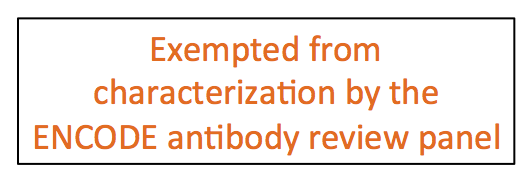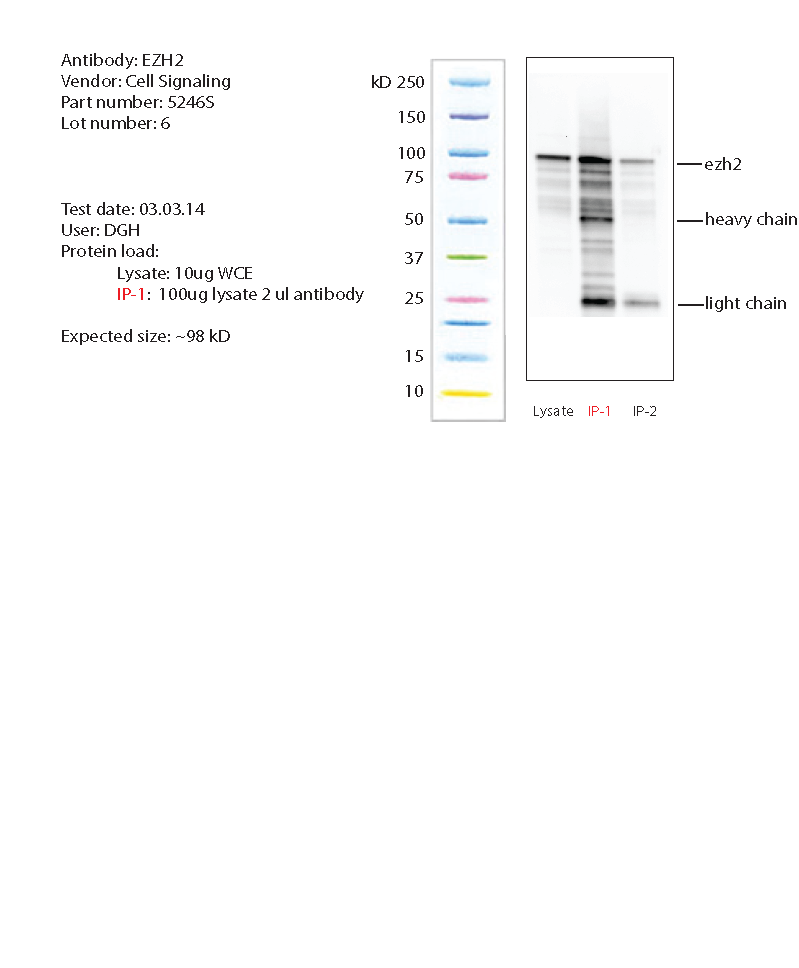ENCAB913HCF
Antibody against Homo sapiens EZH2
Homo sapiens
K562, HeLa-S3
characterized to standards
Homo sapiens
smooth muscle cell, GM23338, SK-N-MC, A673, neural progenitor cell, HCT116, fibroblast of arm, KMS-11, hepatocyte, OCI-LY7, DOHH2, OCI-LY1, GM23248
characterized to standards with exemption
- Status
- released
- Source (vendor)
- Cell Signaling
- Product ID
- 5246S
- Lot ID
- 6
- Characterized targets
- EZH2 (Homo sapiens)
- Host
- rabbit
- Clonality
- monoclonal
- Antigen description
- enhancer of zeste homolog 2 (Drosophila)
- Aliases
- bradley-bernstein:PchAb 1206, bradley-bernstein:PchAb 1290
- External resources
Characterizations
EZH2 (Homo sapiens)
smooth muscle cellGM23338SK-N-MCA673neural progenitor cellHCT116K562fibroblast of armKMS-11hepatocyteOCI-LY7DOHH2OCI-LY1GM23248
exempt from standards
- Caption
- Both ENCODE submitter and reviewer have agreed that this is a well-established antibody lot. Hence it does not require additional validation as standardized by the ENCODE Consortium.
- Submitter comment
- The lab requests that this is considered a well-documented antibody lot and therefore does not require additional validation.
- Reviewer comment
- Dr. Peggy J Farnham: I would support a “no additional validation needed” classification for this antibody.
- Submitted by
- Nina Farrell
- Lab
- Bradley Bernstein, Broad
- Grant
- UM1HG009390
- Download
- exempted.png
EZH2 (Homo sapiens)
Method: ChIP-seq comparison
compliant
- Caption
- This validation relies on the use of antibodies to a chromatin regulator and a functionally related histone modification in A673 cells, and the demonstration that highly similar (>0.9) patterns of enrichment are obtained with each antibody. The first antibody is to phosphorylated EZH2 (PchAb 1206, ENCAB913HCF), and the second antibody is to H3K27me3 previously characterized to Encode standards (PchAb 848, ENCAB036YAO).
- Submitted by
- Nina Farrell
- Lab
- Bradley Bernstein, Broad
- Grant
- U54HG006991
- Download
- EZH2 PchAb 1206 WIP SAV.pdf
EZH2 (Homo sapiens)
Method: ChIP-seq comparison
compliant
- Caption
- This validation relies on the use of antibodies to a chromatin regulator and a functionally related histone modification in A673 cells, and the demonstration that highly similar (>0.9) patterns of enrichment are obtained with each antibody. The first antibody is to phosphorylated EZH2 (PchAb 1206, ENCAB913HCF), and the second antibody is to H3K27me3 previously characterized to Encode standards (PchAb 848, ENCAB036YAO).
- Submitted by
- Nina Farrell
- Lab
- Bradley Bernstein, Broad
- Grant
- U54HG006991
- Download
- EZH2 PchAb 1290 WIP SAV.pdf
EZH2 (Homo sapiens)
HeLa-S3K562
Method: immunoblot
compliant
- Caption
- We performed a WB using 0.7ug unmodified recombinant Histone H3 (Millipore 14-494), 20ug of HeLa nuclear lysate and 20ug of K562 nuclear lysate. Lysates were resolved by electrophoresis on a 4-12% bis-tris gel. After separation, the samples were transferred to a nitrocellulose membrane with an Invitrogen iBlot system. Membrane was blocked for an hour at room temperature, with 5% nonfat dry milk in TBST. The primary antibody was diluted in TBST and 5% BSA at the appropriate concentration over night at 4C. Membrane was washed and blotted with secondary HRP-conjugated antibody for 1 hour at room temp. Detection was made with Optiblot ECL Detect Kit (ab133406) for 1 min. Band of expected size (~98kDa) visualized in both nuclear lysates and could not be detected in the unmodified recombinant Histone H3. Antibody seems to be specific since no reactivity with non histone proteins or unmodified histones was detected.
- Submitted by
- Nina Farrell
- Lab
- Bradley Bernstein, Broad
- Grant
- U54HG006991
EZH2 (Homo sapiens)
K562K562
compliant
- Caption
- K562 whole cell lysate was immunoprecipitated using primary antibody, and the IP fraction along side a whole cell lysate were loaded on a CriterionXT gel and separated. After separation, the samples were transferred using a wet transfer. Blotting with primary (same as that used for IP) and secondary HRP-conjugated antibodies was performed. Band of expected size visualized representing strongest signal in the lane (IP-1).
- Submitted by
- Noam Shoresh
- Lab
- Bradley Bernstein, Broad
- Grant
- U54HG006991
- Download
- ezh2_cell_signaling_5246S_IP.png

